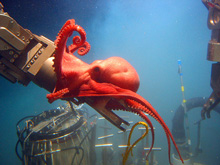This stunning octopod, Benthoctopus sp., seemed quite interested in Alvin's port manipulator arm, during last year’s Expedition to the Deep Slope. Those inside the human-occupied submersible were surprised by the octopod's inquisitive behavior. Click image for larger view and image credit.
Expedition to the Deep Slope 2007
June 4 – July 6, 2007
The Expedition to the Deep Slope 2007 continues our exploration and study of hydrocarbon seep communities found in waters deeper than 1,000 meters (m) in the Gulf of Mexico. Funded by the Minerals Management Service (MMS), the leader in supporting the scientific characterization of seep communities in the Gulf of Mexico, and the NOAA Ocean Exploration (OE) program, our diverse team of scientists will be using the remotely operated vehicle (ROV) Jason II and the NOAA research vessel (R/V) Ronald H. Brown. Our team includes U.S. scientists who have led the exploration, discovery, and study of the Gulf of Mexico cold seeps for the last 20 years, as well as leading international seep scientists from Germany, France, and Austria.
We will be revisiting several of the sites discovered in 2006 to see how much some of the animals have grown and how the animal communities have changed. We will also be diving on at least four sites that have never before been visited. Our team of geologists, geochemists, microbiologists, physiologists, and ecologists will be working side by side to maximize what can be learned about the deep Gulf of Mexico cold seep and coral communities during this month-long expedition of exploration and study.
Related Link
Expedition to the Deep Slope 2006
Learn about the discoveries made on last year's mission.
Updates & Logs
Click images or links below for detailed mission logs and updates.
 July 3 On the last dive of the expedition, the team discovers one of the largest-known mussel beds in the deep Gulf of Mexico.
July 3 On the last dive of the expedition, the team discovers one of the largest-known mussel beds in the deep Gulf of Mexico.
 July 2 As a platform for scientific research, the NOAA research vessel Ronald H. Brown is in a class by herself.
July 2 As a platform for scientific research, the NOAA research vessel Ronald H. Brown is in a class by herself.
 June 27 One of the tasks of this expedition is to study meiofauna — creatures less than one millimeter long.
June 27 One of the tasks of this expedition is to study meiofauna — creatures less than one millimeter long.
 June 26 During a dive with the Jason remotely operated vehicle (ROV), the team comes across an example of natural asphalt.
June 26 During a dive with the Jason remotely operated vehicle (ROV), the team comes across an example of natural asphalt.
 June 24 The expedition surveys the Green Canyon site and returns with photos and samples of deep-water hard corals.
June 24 The expedition surveys the Green Canyon site and returns with photos and samples of deep-water hard corals. June 15 Another important goal of the mission is to understand food web dynamics: Who eats whom on the sea floor.
June 15 Another important goal of the mission is to understand food web dynamics: Who eats whom on the sea floor.
 June 9 Maps, including three-dimensional versions, are essential to understanding the sea-floor topography in the Gulf of Mexico.
June 9 Maps, including three-dimensional versions, are essential to understanding the sea-floor topography in the Gulf of Mexico.
 June 5 Months, and sometimes years, of planning and coordination are necessary for a safe, organized, and productive expedition.
June 5 Months, and sometimes years, of planning and coordination are necessary for a safe, organized, and productive expedition.














































